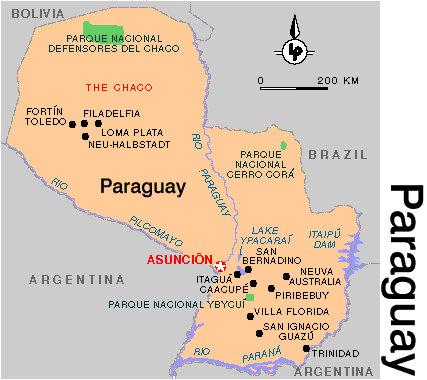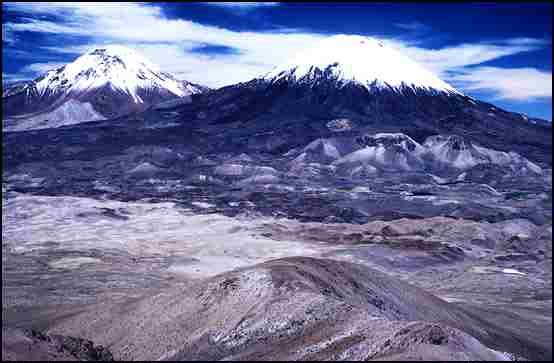| Introduction |
| Environmental Issues in LA |
| Mexico |
| Central America |
| Caribbean |
| Guiana Highlands |
| Andean Region |
| Brazil |
| Southern Cone |
| Future |
Paraguay
Starting in January 1996, an ecological group in Paraguay launched
and electronic media campaign over radio and television in order to educate
the people of Paraguay about their country’s environmental problems.
The group’s director, Edith Asibey, hopes the campaign will get people
involved. Paraguay’s environmental problems include deforestation
and contaminated water.

Sources:
“Broadcasting Paraguay’s Environmental Problems”
http://www2.planeta.com/mader/planeta296/0296paraguay.html
The Lonely Planet
http://http0542.hosting.connect.com.au/dest/sam/graphics/map-par.htm
![]()
Uruguay
In Uruguay, the development of forest plantations is very much beneficial
to the Uruguayan economy and the forests are in no danger of being depleted,
but the plantations of eucalyptus and pine trees are a threat to many native
plants. The planting of eucalyptus trees also degrades both watercourses
and soil texture due their high level of water consumption.

Sources:
“Forestry Development Strikes Note of Alarm”
http://www.oneworld.org/ips2/aug98/19_55_083.html
The Lonely Planet
http://www.lonelyplanet.com.au/dest/sam/graphics/map-uru.gif
![]()
Argentina
In January 1999, a German ship and a Liberian oil tanker collided spilling
30,000 tons of crude oil into Argentina’s Rio de la Plata. The spill
was harmful due to a UNESCO Biosphere Reserve, several other nature reserves,
and an estuary commonly home to river dolphins which were all in the area
of the spill.
Former under-secretary of the environment in Argentina, Hector Dalmau, attributes severe flooding of the rivers of the Rio de la Plata basin not to natural disaster, but rather to “negligence and improvidence.” Deforestation of 60% of Argentina’s forests has led to the swelling of the river basin. The forests of Argentina used to absorb 80% of the rainwater, but the soil cannot absorb as much as the trees do, and is therefore washed away. Not only does this lead to flooding, but the organic material that makes the land fertile is also washed away.
The objective of piping gas from Argentina to northern Chile is threatening the jungle lands of the Kolla indigenous people. Installing the pipeline meant making 12 meter wide swaths through the jungle. The jungle being sacrificed is not only home to the Kolla, but also South America’s largest sub-species of jaguar the yaguarete.

Sources:
“Oil Spilled in Argentina’s Rio de la Plata”
http://ens.lycos.com/ens/jan99/1999L-01-19-04.html
“Logging, Global Warming Behind the Floods”
http://www.oneworld.org/ips2/may98/16_16-064.html
“Greenpeace Films Death of a Jungle in Argentina”
http://www.oneworld.org/ips2/aug98/21_07_091.html
The Lonely Planet
http://www.lonelyplanet.com.au/dest/sam/graphics/map-arg.htm
![]()
Chile
Scientists from the Federico Santa Maria Technical University (UTFSM)
detected a thinning of the ozone layer over the central and southern zone
of Chile which had reached a diameter of more than 1000 square kilometers.
The oval hole stretches from Santiago to Puerto Aisen covering the same
latitudes of Argentina as it reaches from the Pacific to the Atlantic.
It was reported that one spot had reached as low as 204 Dobson Units (DU).
One  hundred
DU means one millimeter of ozone thickness and less than 220 units means
risk for human beings to ultraviolet radiation. It is warned that
1998 and 1999 will be the most critical years of ozone depletion.
hundred
DU means one millimeter of ozone thickness and less than 220 units means
risk for human beings to ultraviolet radiation. It is warned that
1998 and 1999 will be the most critical years of ozone depletion.
The Chilean capital of Santiago is surrounded by mountains and therefore lacks its own wind system, which causes a concentration of masses of contaminated air. An environmental pre-emergency is issued when air contamination indices reach the 300 mark. Authorities usually issue a vehicle restriction of 40% and suspend the action of all sources with pollution emission over 90. Infants and the elderly are the most sensitive to the air contamination.
For the first time in June 1998, a Chilean council required than an
investor provides “environmental insurance” in case it fails to comply
with environmental specifications. This will affect a United States
project to log an endangered species of tree out of the Southern tip of
Chile. The US company produces wood chips for “green friendly” packaging.
Chip Environmental Report

Sources:
“New Ozone Hole Over Chile and Argentina”
http://www.oneworld.org/ips2/may/ozone.html
“Ozone Layer Thinning Earlier”
http://www.oneworld.org/ips2/sept98/20_33_081.html
“Contamination Keeps Vice-Like Grip on Santiago”
http://www.oneworld.org/ips2/jul/chile.html
“New Measures Against Logging Project”
http://www.oneworld.org/ips2/june98/20_19_069.html
The Lonely Planet
http://www.lonelyplanet.com.au/dest/sam/graphics/map-chi.htm